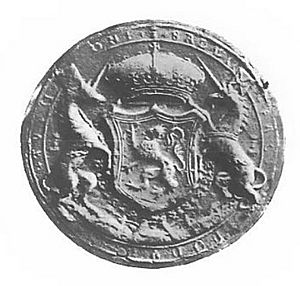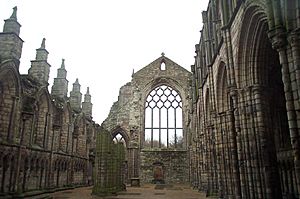Royal Court of Scotland facts for kids
The Royal Court of Scotland was the main place where the Kingdom of Scotland was governed. It was also a center for art and politics. This court started in the 900s. It continued until 1603 when King James VI of Scotland also became King of England.
For a long time, the Scottish kings did not have one fixed capital city. Forteviot was an early royal home. Later, Scone became important for royal activities. Edinburgh only started to become the capital during the time of King James III. Even then, kings would still travel to different parts of the country.
At first, we don't know much about the court's structure. But by the time of King David I, it became more organized. It had important roles like the Steward, Chamberlain, Constable, Marischal, and Lord Chancellor. Later, the court included important nobles, officials, and visitors. The Chancellor became like the king's main minister. From the mid-1500s, the Chancellor led the Privy Council.
The main language of the court changed over time. From King David I's reign, French likely replaced Gaelic. Later, in the late Middle Ages, Middle Scots became the main language. Ideas of chivalry (knightly behavior) became popular during King David II's time. Tournaments were a big part of this. In the 1400s, the Scottish court copied the style of the Burgundian court. This made it a center for culture and politics. By the 1500s, the court helped spread Renaissance art and ideas. It also hosted grand events to show the power of the monarchy.
The court had poets, musicians, and artists. Early on, there were filidh, who were poets and historians. Later, bards took over, often playing the harp. King James I brought new music styles from England. Many Scottish poets, called makars, were connected to the court. King James VI supported a group of poets and musicians called the Castalian Band. Artists from Europe, especially the Netherlands, created impressive works for the court. Artists like Arnold Bronckorst and Adrian Vanson painted portraits of the king and other important people. Royal palaces were also built and rebuilt, especially under the Stuart kings.
Kings spent a lot on fancy clothes, good food, and supporting art and music. This started with King James I. However, managing these costs was often a challenge. After King James VI became King of England in 1603, the Scottish court stopped existing. It was no longer a center for art, politics, or royal events.
Contents
Where Was the Royal Court Located?

For most of the Middle Ages, the king and his court traveled a lot. They did not have one fixed capital city. The ancient Pictish center of Forteviot was an early royal home. Kings like Cinaed mac Ailpin (Kenneth MacAlpin) and Domnall mac Ailpín (Donald I MacAlpin) used it. Later, it remained important until the 1100s.
King David I tried to make Roxburgh a royal center. But in the 1100s and 1200s, Scone was the most common place for royal business. Other popular places included Perth, Stirling, Dunfermline, and Edinburgh.
The Wars of Independence (1296–1357) greatly affected the court. It almost stopped working. But Robert I and the later Stuart kings brought it back. They used it to show national pride. In the later Middle Ages, the king moved between royal castles. Perth and Stirling were often used.
Edinburgh started to become the capital during King James III's reign (1460–88). This was not always popular. Many felt the king should visit all parts of the kingdom. Even when based at Holyrood Palace in Edinburgh, the king and court still visited other palaces. These included Linlithgow, Stirling, and Falkland. They traveled to ensure laws were followed and the government ran smoothly.
Who Was Part of the Royal Court?
Important Roles in the Court
We don't know much about the court's structure before King David I. Some early roles might have been Gaelic in origin. These included clerks who managed food and the Hostarius (or Usher) who led the royal guards. By the late 1200s, the court became more like a feudal system.
The main roles were the Steward, Chamberlain, Constable, Marischal, and Lord Chancellor. The Steward managed the king's household. This role became hereditary for Walter Fitzalan's family, who later became the Stewart kings. The Steward role merged with the crown when Robert II became king.
Other major roles also tended to be passed down in families. The Chamberlain handled royal money. The Constable organized the army. The Marischal was a battle leader. The Chancellor was usually a church leader in the Middle Ages. He was in charge of the king's chapel, which was also the main office for the government. He controlled letters, legal documents, and seals. From James III's time, important non-church leaders increasingly became Chancellor.
By the early modern period, the court included nobles, officials, ambassadors, and people seeking favors. The monarch and their close advisors were at the center. These advisors, called Gentlemen of the Chamber, were often nobles or related to noble families. They had direct access to the king or queen.
The Chancellor was now the kingdom's main minister. From the mid-1500s, he led the Privy Council. His department, the Chancery, was responsible for the Great Seal. This seal was needed for land titles and transfers. The Chancellor's main job was to lead Privy Council meetings.
The Secretary was the second most important official. He managed Privy Council records and foreign policy. This role remained important even after Scotland and England shared a king in 1603. The Treasurer handled royal money, along with the Comptroller. The Comptroller's office later merged with the Treasurer's in 1610.
The Lord President of the Court of Session connected the Privy Council and the court. The king's advocate was the legal advisor. This role started in the 1490s to deal with the king's land rights. From 1579, they also became public prosecutors. Most of these roles continued after 1603. However, political power shifted more to London.
The King's Council and Privy Council
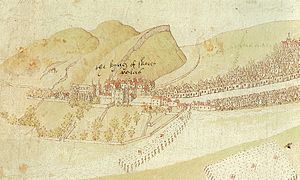
After the king, the most important government group in the late Middle Ages was the king's council. It was made up of the king's closest advisors and led by the Lord Chancellor. Unlike in England, Scotland's king's council could make laws and judge cases. It was quite small, usually with fewer than 10 members. Some members were chosen by parliament, especially when the king was a child. This helped limit the power of the regent (someone ruling for the child king).
By the late 1400s, the council worked almost full-time. Records show it was vital for royal justice. While important nobles were technically members, they rarely attended. Most active members were career administrators and lawyers. Many were church leaders with university education. Later, more educated non-church members joined, often lawyers.
The Privy Council grew out of the king's council in the 1500s. "Secret Councils" had existed during times when child kings ruled. But the Privy Council officially started in 1543, when Mary, Queen of Scots was a child. It continued even after she became an adult queen. When in Edinburgh, the Privy Council met at Holyrood Palace. When the monarch traveled, the council often went with them. If the monarch was on holiday, the council usually stayed in Edinburgh to run the government.
The Privy Council's main job was to judge cases. But it also advised the monarch. It acted as the government when the monarch was absent or a child. The monarch often attended, but their presence was not always needed for the council to act with royal power. Like parliament, it could issue acts that became law. Although about 30 people were officially members, a smaller group of state officials did most of the work.
Court Culture and Arts
Language at Court
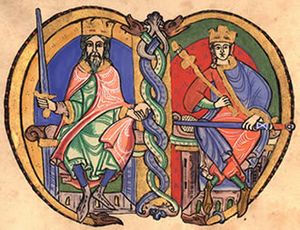
The joining of the Gaelic and Pictish kingdoms created the kingdom of Alba. This led to Gaelic language and culture being dominant. But from King David I's reign (1124–53), French likely replaced Gaelic as the main court language. This was part of a big change that brought French culture to Scotland. King David's successors, Malcolm IV and William I, even said they were French in their ways and language.
However, Gaelic culture remained at court. Gaelic musicians and poets were still supported by King James IV (1488–1513), who spoke Gaelic himself. In the late Middle Ages, Middle Scots became the main language of the country. It came from Old English, with words from Gaelic, French, and Scandinavian languages. By the 1400s, Middle Scots was the language of government and the court.
Courtly Display and Chivalry
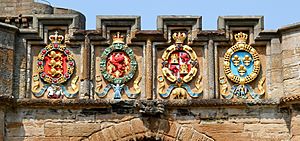
Ideas of chivalry became popular in Scotland during King David II's reign (1329–71). This was similar to what happened in England. Tournaments were a key way to show off chivalry. For example, in 1449, famous knights fought at Stirling Castle. By the early 1500s, chivalry became more about honor and show than actual fighting.
King James IV held tournaments with an Arthurian theme in 1507 and 1508. King James V (1513–42) loved tournaments. He was proud to be a member of international knightly orders. He displayed their symbols on the gateway at Linlithgow Palace.
The Scottish court in the 1400s copied the Burgundian court. This meant more formal events, elegance, and grand displays. The court became a center for culture and politics. By the 1500s, the court was important for spreading Renaissance ideas and art. It also hosted lavish events to show the monarchy's power.
When Mary, Queen of Scots returned from France in 1561, she brought many French court activities. These included balls, masques, and celebrations. They were meant to show the monarchy's strength and unite the country. There were grand events for her husband Darnley in 1566. A three-day festival celebrated the baptism of her son, James VI, in December 1566. This included a mock attack on a fort by "wild highlanders." This symbolized the dynasty protecting the nation. Under King James VI, the court became a center for culture and learning again. He presented himself as a wise, philosopher king.
Music at the Royal Court
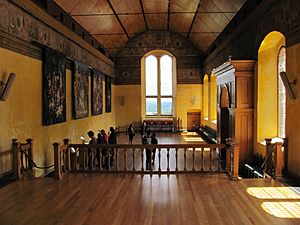
Early Scotland and Ireland shared a culture. In Ireland, filidh were poets, musicians, and historians for lords and kings. They passed down Gaelic knowledge. After the Scottish court became less Gaelic, bards took over. They often played the harp with their poetry.
King James I was held captive in England from 1406 to 1423. He became known as a poet and composer there. When he returned, he likely brought English and European music styles to the Scottish court. King James III was interested in music. He founded a new Chapel Royal at Restalrig for many singers. In 1501, his son James IV rebuilt the Chapel Royal at Stirling Castle. He made the choir larger to be like St. George's Chapel at Windsor Castle. This became the main place for church music in Scotland.
Scottish courts followed the trend of using instruments. King James V was a talented lute player. He brought French songs and groups of instruments (viols) to his court. However, almost none of this music survives. When Mary, Queen of Scots returned from France in 1561, she gave new life to the Chapel Royal choir. She played the lute, virginals, and was a good singer. She brought French musical influences, hiring lutenists and viol players.
King James VI (1566–1625) strongly supported the arts. He rebuilt the Chapel Royal at Stirling in 1594. The choir was used for big events like the baptism of his son Henry. He hired lutenists for his entertainment, as did his family. King James VI and his wife Anne of Denmark enjoyed dancing in costumes at masques.
Literature at Court

The first important Scottish literature text is John Barbour's Brus (1375). It was supported by King Robert II. This epic poem tells the story of Robert I and the Wars of Independence. It was very popular. Barbour is seen as the father of Scots poetry.
Many Middle Scots poems were written by makars (poets) connected to the royal court. This included King James I, who wrote the long poem The Kingis Quair.
King James IV (1488–1513) created a Renaissance court. He supported poets, mostly churchmen. These included Robert Henryson (c. 1450-c. 1505), who rewrote old stories. William Dunbar (1460–1513) wrote satires and lyrics. Gavin Douglas (1475–1522), who became a bishop, brought Humanist ideas into his poetry. His most important work was his translation of Virgil's Aeneid, called the Eneados. It was the first full translation of a major classical text into an English-like language.
King James V supported poets like William Stewart and John Bellenden. David Lyndsay (c. 1486–1555), a diplomat, was a very productive poet. He wrote stories, romances, and satires. George Buchanan (1506–82) was an important Latin poet.
From the 1550s, during Mary, Queen of Scots' reign and her son James VI's childhood, cultural activities were limited. This was due to political problems and the lack of a strong royal court. The church also discouraged poetry that wasn't religious. However, poets like Alexander Hume (c. 1556–1609) still wrote. Alexander Scott's (?1520-82/3) short poems, meant to be sung, influenced later poets.
In the 1580s and 1590s, King James VI strongly promoted Scottish literature. He wrote a book called Some Rules and Cautions to be Observed and Eschewed in Scottish Prosody in 1584. It was a guide for poetry and described the Scottish poetic tradition. He became a patron and member of the Castalian Band. This group included poets like William Fowler and Alexander Montgomerie. They translated important Renaissance texts and wrote poems using French styles. By the late 1590s, the king's focus on Scottish tradition lessened as he hoped to become King of England.
Art at the Royal Court
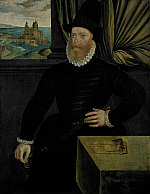
From the 1400s, court records mention artists. Matthew, the "king's painter," is first mentioned in 1434. Most impressive artworks and artists came from Europe, especially the Netherlands. The Netherlands was a center for painting during the Northern Renaissance.
Examples include Hugo van Der Goes's altarpiece for the Trinity College Church in Edinburgh. This was ordered by King James III. There are also many beautiful religious books from the late 1400s and early 1500s. These were usually made in the Low Countries and France for Scottish patrons. One example is the Hours of James IV of Scotland, given by King James IV to Margaret Tudor. It is called "perhaps the finest medieval manuscript to have been commissioned for Scottish use."
Around 1500, Scottish kings started having their portraits painted. These were usually oil paintings on wood. In 1502, King James IV paid for portraits of the Tudor family. He also hired an "Inglishe payntour" named "Mynours" to paint him and his new wife, Margaret Tudor. This painter was Meynnart Wewyck, a Flemish artist who worked for Henry VII in London.
Royal portrait painting in Scotland was often interrupted by periods when child kings ruled. King James V was more interested in grand buildings to show royal power. Mary, Queen of Scots grew up in the French court, where she was drawn by famous artists. But she did not order many adult portraits. This might have been a Scottish tradition, where heraldic symbols or elaborate tombs were more important than portraits.
In King James VI's reign, Renaissance portrait styles became popular. He hired two Flemish artists, Arnold Bronckorst (in the early 1580s) and Adrian Vanson (from 1584 to 1602). They created many portraits of the king and important court figures.
Royal Architecture
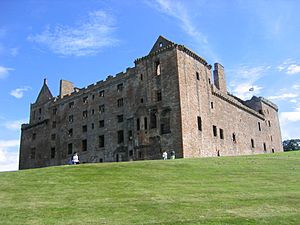
The royal center at Forteviot was not built for defense. But there is evidence of impressive art and architecture there. The Dupplin Cross is a notable sculpture found nearby.
When feudalism came to Scotland in the 1100s, castles were built. Royal castles were larger. They provided defense, lodging for the traveling court, and local government centers. By 1200, there were castles at Ayr and Berwick. King Alexander II (1198–1249) and King Alexander III (1249–86) built many modern castles. But this ended with Alexander III's early death and the Wars of Independence.
Under the Stuart kings, there was a big program of building and rebuilding royal palaces. This started with King James III, sped up under James IV, and peaked under James V. These buildings showed the influence of Renaissance architecture.
Linlithgow was first built under King James I (1406–27). It was called a "palace" from 1429, which was the first time this term was used in Scotland. It was expanded under James III. It looked like an Italian palace with four towers, mixing classical style with knightly images. Italian builders might have worked for James IV. During his reign, Linlithgow was finished, and other palaces were rebuilt with Italian proportions.
In 1536, King James V visited France for his marriage. He saw French Renaissance architecture there. His second marriage to Mary of Guise two years later brought more connections. A talented French wood-carver, Andrew Mansioun, settled in Edinburgh. Scottish architecture adopted European styles rather than just copying England's. These styles were mixed with traditional Scottish designs and materials like stone.
Buildings at Linlithgow were followed by rebuilding at Holyrood Palace, Falkland Palace, Stirling Castle, and Edinburgh Castle. These are considered "some of the finest examples of Renaissance architecture in Britain." Many building projects were planned and funded by James Hamilton of Finnart, a key official for James V.
From the mid-1500s, royal building work was less common. Some minor work was done at Edinburgh Castle after a siege in 1575. A viewing platform was added to Stirling Castle in the 1580s. Work for King James VI by William Schaw showed continued Renaissance influences. This included the classical entrance of the Chapel Royal at Stirling, built in 1594.
How Was the Court Funded?
Kings spent a lot on fancy clothes, good food, and supporting new architecture, art, and music. This started with King James I. King James III is thought to have saved money. Despite his lavish spending, James IV managed his finances well. This was likely due to more money coming from royal lands. His income from these lands doubled during his reign.
King James V could spend a lot because of two dowries from the King of France. He also used the wealth of the church. Even so, his spending kept pace with his growing income. Mary, Queen of Scots tried to create a French-style court. But she faced financial limits. Prices were also rising during her time.
The court of King James VI was very expensive. This might have been one reason for the Ruthven Raid in 1582, an attempted coup. After his marriage to Anne of Denmark in 1589–90, court spending became even more out of control. Clothes for the king, queen, and servants were paid for by money from Queen Elizabeth of England.
By late 1591, the rising costs led to ideas for cutting spending on food and clothes. They also looked for ways to increase money from royal assets. The last part of the queen's dowry, 54,000 Danish dalers, was spent on the grand court entertainment and masque for the baptism of Prince Henry in August 1594. A group of courtiers called the Octavians tried to save money in the queen's household. They were given control of the treasury. But they angered powerful nobles and were dismissed in 1598.
What Happened to the Royal Court?
After King James VI inherited the English throne in 1603, the Scottish court basically stopped existing. It no longer served as a center for art, political display, or intrigue. Some Scottish poets and musicians went with the king to London. They continued to write, but their language soon became more English. The Chapel Royal in Scotland began to fall apart. The court in Westminster (London) became the only major source of royal music. This led to a shift where nobles and local landowners became the main supporters of art.
The Privy Council in Scotland became a group that simply followed instructions from London. Holyrood Abbey was rebuilt as a chapel for King Charles I's visit in 1633. King Charles II reclaimed Holyrood after the Restoration. The future King James VII lived there in the early 1680s, running a small court. However, it was attacked by a mob during the Glorious Revolution in 1688 and was never repaired.


